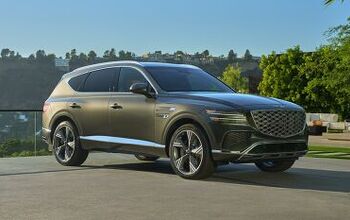Senate Finance Committee Approves $12,500 EV Tax Credit Bill

On Wednesday, the Senate Finance Committee advanced the Clean Energy for America Act making a few tweaks from earlier proposals. Changes include raising the federal EV tax rebate ceiling to $12,500 and opening the door for automakers who already exhausted their production quotas.
It’s good news for General Motors, which recently begged the government for just such a handout. But any manufacturer participating in the sale of electric vehicles will find themselves similarly blessed by the updated rules — assuming they make it through the halls of Capitol Hill with the necessary support.
Let’s take a peek behind the curtain to see what the updated proposal entails.
While the $7,500 tax credit persists, the bill now adds special exemptions depending on how the vehicle is manufactured For example, the government will tack on another $2,500 if final assembly takes place inside the United States and another $2,500 if the factory in question happens to be represented by a union. While the latter inclusion seems concerningly political, there doesn’t appear to be any language stipulating whether not it matters if unionized plants have to be located in the country for the vehicle to be eligible.
It’s also probably one of the biggest reasons why the committee advanced the legislation on a tie split evenly (14-14) along party allegiances. But the rules say the bill only gets the kibosh if it loses the vote, so the deadlock still means it can be sent all the way to the Senate. But some of the particulars might make its pathway there incredibly difficult.
Perhaps the most fiscally irresponsible aspect of the proposal involves ending any caps on vehicle production. Early incarnations of the EV tax credit were intended only to get the ball rolling on alternative energy vehicles, so they would gain public acceptance. But the Clean Energy for America Act will continue issuing credits until electric vehicles become over half of a company’s annual sales. Even then, there will be a phase-out period where rebates would be scaled back over two years — similar to how things work under the current rules.
This is an insane amount of money for any government to effectively hand over to automotive manufacturers with no definitive end date. We have no real way of knowing when EVs will supplant the internal combustion engine as the dominant powertrain. These subsidies could last for decades, extending well beyond the point where electrically driven cars reach financial parity with ICEs. They also won’t be linked to the Biden infrastructure plan, which is striving to create $100 billion in additional rebates for electric cars.
Let’s not forget all this money is supposed to be coming from America’s tax base and there’s literally no way to even begin estimating what the total cost will be.
The Clean Energy for America Act basically throws any notion of there being a free auto market out the window. It incentives the building and purchase of EVs to such a degree that there would be little reason to continue pursuing gasoline or diesel development. Even they were suddenly proven to be better for the environment or consumers than plug-ins, the payout for running with EVs would still be far too big to ignore. I believe the correct term for this is a “planned economy,” as it technically shapes/restrains existing consumer demand in favor of greater capital investments for economic development in a manner that suits government goals.
In fact, the only aspect of the proposal that seems to exercise any financial restraint is the MSRP eligibility limit of $80,000. This is designed to prohibit wealthy individuals from taking advantage of the federal tax credits. However, most high-end electrics currently on the market already come in below the cutoff — including the Porsche Taycan and Tesla Model S.
[Image: Nmorguelan/Shutterstock]

A staunch consumer advocate tracking industry trends and regulation. Before joining TTAC, Matt spent a decade working for marketing and research firms based in NYC. Clients included several of the world’s largest automakers, global tire brands, and aftermarket part suppliers. Dissatisfied with the corporate world and resentful of having to wear suits everyday, he pivoted to writing about cars. Since then, that man has become an ardent supporter of the right-to-repair movement, been interviewed on the auto industry by national radio broadcasts, driven more rental cars than anyone ever should, participated in amateur rallying events, and received the requisite minimum training as sanctioned by the SCCA. Handy with a wrench, Matt grew up surrounded by Detroit auto workers and managed to get a pizza delivery job before he was legally eligible. He later found himself driving box trucks through Manhattan, guaranteeing future sympathy for actual truckers. He continues to conduct research pertaining to the automotive sector as an independent contractor and has since moved back to his native Michigan, closer to where the cars are born. A contrarian, Matt claims to prefer understeer — stating that front and all-wheel drive vehicles cater best to his driving style.
More by Matt Posky
Latest Car Reviews
Read moreLatest Product Reviews
Read moreRecent Comments
- Bd2 Lexus is just a higher trim package Toyota. ^^
- Tassos ONLY consider CIvics or Corollas, in their segment. NO DAMNED Hyundais, Kias, Nissans or esp Mitsus. Not even a Pretend-BMW Mazda. They may look cute but they SUCK.I always recommend Corollas to friends of mine who are not auto enthusiasts, even tho I never owed one, and owned a Civic Hatch 5 speed 1992 for 25 years. MANY follow my advice and are VERY happy. ALmost all are women.friends who believe they are auto enthusiasts would not listen to me anyway, and would never buy a Toyota. They are damned fools, on both counts.
- Tassos since Oct 2016 I drive a 2007 E320 Bluetec and since April 2017 also a 2008 E320 Bluetec.Now I am in my summer palace deep in the Eurozone until end October and drive the 2008.Changing the considerable oils (10 quarts synthetic) twice cost me 80 and 70 euros. Same changes in the US on the 2007 cost me $219 at the dealers and $120 at Firestone.Changing the air filter cost 30 Euros, with labor, and there are two such filters (engine and cabin), and changing the fuel filter only 50 euros, while in the US they asked for... $400. You can safely bet I declined and told them what to do with their gold-plated filter. And when I changed it in Europe, I looked at the old one and it was clean as a whistle.A set of Continentals tires, installed etc, 300 EurosI can't remember anything else for the 2008. For the 2007, a brand new set of manual rec'd tires at Discount Tire with free rotations for life used up the $500 allowance the dealer gave me when I bought it (tires only had 5000 miles left on them then)So, as you can see, I spent less than even if I owned a Lexus instead, and probably less than all these poor devils here that brag about their alleged low cost Datsun-Mitsus and Hyundai-Kias.And that's THETRUTHABOUTCARS. My Cars,
- NJRide These are the Q1 Luxury division salesAudi 44,226Acura 30,373BMW 84,475Genesis 14,777Mercedes 66,000Lexus 78,471Infiniti 13,904Volvo 30,000*Tesla (maybe not luxury but relevant): 125,000?Lincoln 24,894Cadillac 35,451So Cadillac is now stuck as a second-tier player with names like Volvo. Even German 3rd wheel Audi is outselling them. Where to gain sales?Surprisingly a decline of Tesla could boost Cadillac EVs. Tesla sort of is now in the old Buick-Mercury upper middle of the market. If lets say the market stays the same, but another 15-20% leave Tesla I could see some going for a Caddy EV or hybrid, but is the division ready to meet them?In terms of the mainstream luxury brands, Lexus is probably a better benchmark than BMW. Lexus is basically doing a modern interpretation of what Cadillac/upscale Olds/Buick used to completely dominate. But Lexus' only downfall is the lack of emotion, something Cadillac at least used to be good at. The Escalade still has far more styling and brand ID than most of Lexus. So match Lexus' quality but out-do them on comfort and styling. Yes a lot of Lexus buyers may be Toyota or import loyal but there are a lot who are former GM buyers who would "come home" for a better product.In fact, that by and large is the Big 3's problem. In the 80s and 90s they would try to win back "import intenders" and this at least slowed the market share erosion. I feel like around 2000 they gave this up and resorted to a ton of gimmicks before the bankruptcies. So they have dropped from 66% to 37% of the market in a quarter century. Sure they have scaled down their presence and for the last 14 years preserved profit. But in the largest, most prosperous market in the world they are not leading. I mean who would think the Koreans could take almost 10% of the market? But they did because they built and structured products people wanted. (I also think the excess reliance on overseas assembly by the Big 3 hurts them vs more import brands building in US). But the domestics should really be at 60% of their home market and the fact that they are not speaks volumes. Cadillac should not be losing 2-1 to Lexus and BMW.
- Tassos Not my favorite Eldorados. Too much cowbell (fins), the gauges look poor for such an expensive car, the interior has too many shiny bits but does not scream "flagship luxury", and the white on red leather or whatever is rather loud for this car, while it might work in a Corvette. But do not despair, a couple more years and the exterior designs (at least) will sober up, the cowbells will be more discreet and the long, low and wide 60s designs are not far away. If only the interiors would be fit for the price point, and especially a few acres of real wood that also looked real.


































Comments
Join the conversation
slavuta, Please don't tell me they bought Joey B's money printing press.
Electric cars, especially Tesla vehicles are definitely superior to Gas powered cars. There's a reason why Tesla sales have been DOUBLING every single year for the past 10 years. I can easily see Tesla going from 500K sales last year to over a Million sales this year WITH OR WITHOUT this incentive. As for reaching parity, there's already parity when the Tesla Model 3 costs less to own over 5 years than a Toyota Camry. Why? No need to worry about Gas every day, Oil Changes every 3 months, Brakes every year and so on and so forth. This rebate is unnecessary and it's unlikely that Tesla will be able to more than double annual sales. What they really should do is end subsidies to Oil companies and refineries. End subsidies for Ethanol and other fuel additives.